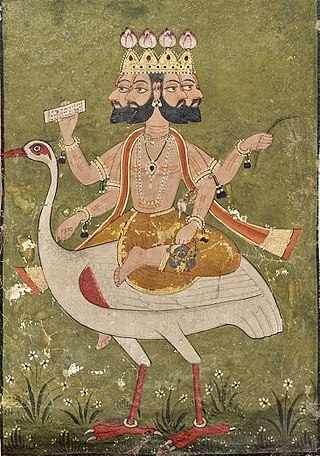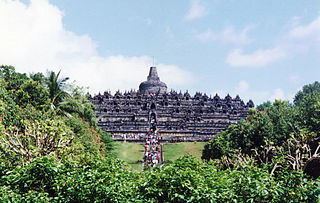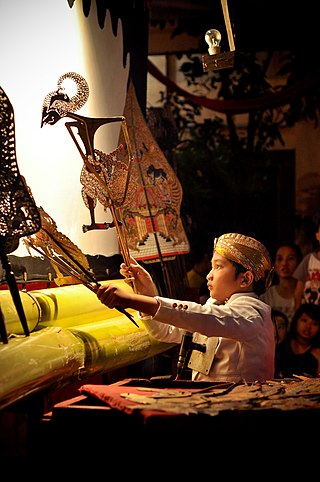
Yama is the Hindu deity of death, dharma, the south direction, and the underworld. Belonging to an early stratum of Rigvedic Hindu deities, Yama is said to have been the first mortal who died in the Vedas. By virtue of precedence, he became the ruler of the departed.

Parvati, also known as Uma and Gauri, is the Hindu goddess of power, energy, nourishment, harmony, love, beauty, devotion, and motherhood. She is one of the central deities of the goddess-oriented sect called Shaktism, and the supreme goddess in Shaivism. Along with Lakshmi and Sarasvati, she forms the Tridevi. In her complete form, she is a physical representation of Mahadevi also known as Adi Shakti, the primordial power behind the creation of the universe, the creator and destroyer according to Shaktism.

Rāhu is one of the nine major celestial bodies (navagraha) in Hindu texts and the king of meteors. It represents the ascension of the Moon in its precessional orbit around the Earth, also referred as the north lunar node, and along with Ketu, is a "shadow planet" that causes eclipses. Despite having no physical existence, Rahu has been allocated the status of the planet by ancient seers owing to its strong influence in astrology.

Balinese Hinduism, also known in Indonesia as Agama Hindu Dharma, Agama Tirtha, Agama Air Suci or Agama Hindu Bali, is the form of Hinduism practised by the majority of the population of Bali. This is particularly associated with the Balinese people residing on the island, and represents a distinct form of Hindu worship incorporating local animism, ancestor worship or Pitru Paksha, and reverence for Buddhist saints or Bodhisattava.

Wayang is a traditional form of puppet theatre play originating from the Indonesian island of Java. Wayang refers to the entire dramatic show. Sometimes the leather puppet itself is referred to as wayang. Performances of wayang puppet theatre are accompanied by a gamelan orchestra in Java, and by gender wayang in Bali. The dramatic stories depict mythologies, such as episodes from the Hindu epics the Ramayana and the Mahabharata, as well as local adaptations of cultural legends. Traditionally, a wayang is played out in a ritualized midnight-to-dawn show by a dalang, an artist and spiritual leader; people watch the show from both sides of the screen.

Balinese mythology is the traditional mythology of the people of the Indonesian island of Bali, before the majority adoption of Hinduism.

Anjana, also known as Anjani and Anjali, is the mother of Hanuman, one of the protagonists of the Hindu epic, the Ramayana. She is said to have been a resident of Kishkindha in the text.

Hinduism is the third-largest religion in Indonesia, based on civil registration data in 2023 from Ministry of Home Affairs, is practised by about 1.68% of the total population, and almost 87% of the population in Bali. Hinduism was the dominant religion in the country before the arrival of Islam and is one of the six official religions of Indonesia today. Hinduism came to Indonesia in the 1st-century through Indian traders, sailors, scholars and priests. A syncretic fusion of pre-existing Javanese folk religion, culture and Hindu ideas, that from the 6th-century also synthesized Buddhist ideas as well, evolved as the Indonesian version of Hinduism. These ideas continued to develop during the Srivijaya and Majapahit empires. About 1400 CE, these kingdoms were introduced to Islam from coast-based Muslim traders, and thereafter Hinduism, which was previously the dominant religion in the region, mostly vanished from many of the islands of Indonesia.

Wayang wong, also known as wayang orang, is a type of classical Javanese and Balinese dance theatrical performance with themes taken from episodes of the Ramayāna or Mahabharāta. Performances are stylised, reflecting Javanese court culture:
Wayang wong dance drama in the central Javanese Kraton of Yogyakarta represents the epitome of Javanese aesthetic unity. It is total theatre involving dance, drama, music, visual arts, language, and literature. A highly cultured sense of formality permeates every aspect of its presentation.

Semar is a character in Javanese mythology who frequently appears in wayang shadow plays. He is one of the punokawan (clowns) but is divine and very wise. He is the dhanyang of Java, and is regarded by some as the most sacred figure of the wayang set. He is said to be the god Sang Hyang Ismaya in human form.

Brahma is a Hindu god, referred to as "the Creator" within the Trimurti, the trinity of supreme divinity that includes Vishnu and Shiva. He is associated with creation, knowledge, and the Vedas. Brahma is prominently mentioned in creation legends. In some Puranas, he created himself in a golden embryo known as the Hiranyagarbha.

In Javanese mythology, Batara Sambu is a deity and the God of Teachers. He is the first-born son of Batara Guru and his queen Batari Uma. Sambu in traditional Javanese wayang story is a god who rules clouds. He has two wives: Bathari Siwagnyana and Bathari Astuti and his kahyangan is called Kahyangan Swelagringging in the southern part of the heavens. His palace is made of copper and his pasaran is Paing. Sambu is the ancestor of rakshasa (giants) in Javanese wayang story.

Dewi Sri or Shridevi is the Javanese, Sundanese, and Balinese Hindu Goddess of rice and fertility, still widely worshiped on the islands of Java, Bali and Lombok, Indonesia. She is often associated or equated with the Hindu goddess Lakshmi, the shakti (consort) of Vishnu.

The mythology of Indonesia is very diverse, the Indonesian people consisting of hundreds of ethnic groups, each with their own myths and legends that explain the origin of their people, the tales of their ancestors and the demons or deities in their belief systems. The tendency to syncretize by overlying older traditions with newer foreign ideas has occurred. For example, the older ancestral mythology might be merged with foreign mythology, such as Hindu, Islam, or Christian biblical mythology.

Wawacan Sulanjana is a Sundanese manuscript containing Sundanese myths. The title means "The Tale of Sulanjana", derived from the name of the hero Sulanjana as the protector of rice plant against the attack of Sapi Gumarang cow, Kalabuat and Budug Basu boars symbolizing rice pestilence. The Wawacan Sulanjana contains Sundanese local wisdom through reverence of rice cultivation in its tradition.

Batara Guru is the name of a supreme god in Indonesian Hinduism. His name is derived from Sanskrit Bhattaraka which means “noble lord". He has been conceptualized in Southeast Asia as a kind spiritual teacher, the first of all Gurus in Indonesian Hindu texts, mirroring the guru Dakshinamurti aspect of Hindu god Shiva in the Indian subcontinent. However, Batara Guru has more aspects than the Indian Shiva, as the Indonesian Hindus blended their spirits and heroes with him. Batara Guru's wife in Southeast Asia is Shiva's consort Durga.

Singhasari temple or Candi Singhasari is a 13th-century syncretic Hindu-Buddhist temple located in Singosari district, Malang Regency, East Java in Indonesia.

Wayang kulit is a traditional form of shadow puppetry originally found in the cultures of Java and Bali in Indonesia. In a wayang kulit performance, the puppet figures are rear-projected on a taut linen screen with a coconut oil light. The dalang manipulates carved leather figures between the lamp and the screen to bring the shadows to life. The narratives of wayang kulit often have to do with the major theme of good vs. evil.

In Balinese temple architecture, a Bhoma is a carved or formed grotesque which decorates certain parts of the Balinese temple complex. The statue is similar to the Javanese Kala, and was intended to protect the temple complex from malevolent spirits.

















